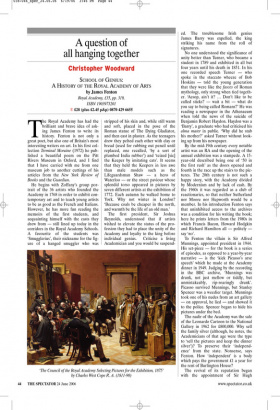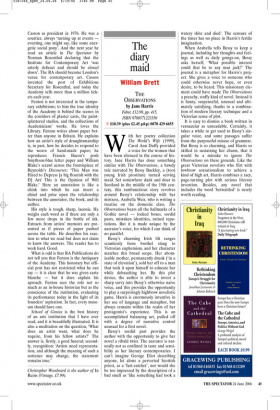A question of all hanging together
Christopher Woodward
SCHOOL OF GENIUS: A HISTORY OF THE ROYAL ACADEMY OF ARTS by James Fenton Royal Academy, £35, pp. 319, ISBN 1903973201 ✆ £28 (plus £2.45 p&p) 0870 429 6655 The Royal Academy has had the brilliant and brave idea of asking James Fenton to write its history. Fenton is not only a great poet, but also one of Britain’s most interesting writers on art. In his first collection Terminal Moraine (1972) he published a beautiful poem on the Pitt Rivers Museum in Oxford, and I find that I have carried with me from one museum job to another cuttings of his articles from the New York Review of Books and the Guardian.
He begins with Zoffany’s group portrait of the 36 artists who founded the Academy in 1768 in order to exhibit contemporary art and to teach young artists to be as good as the French and Italians. However, he has more fun reading the memoirs of the first students, and acquainting himself with the casts they drew from — still lined up today in the corridors in the Royal Academy Schools. A favourite of the students was ‘Smugglerius’, their nickname for the figure of a hanged smuggler who was stripped of his skin and, while still warm and soft, placed in the pose of the Roman statue of The Dying Gladiator, and then cast in plaster. As the teenagers drew they pelted each other with clay or bread (used for rubbing out pencil until replaced, one recalled, ‘by a sort of plumbed India rubber’) and ‘teized [sic] the Keeper by imitating cats’. It seems that they held the Keepers in less awe than male models such as the Lifeguardsman Shaw — a hero of Waterloo — or the street paviour whose splendid torso appeared in pictures by seven different artists at the exhibition of 1772. Each autumn he walked home to York. Why not winter in London? ‘Because coals be cheaper in the north, and warmth be the life of an old man.’ The first president, Sir Joshua Reynolds, understood that if artists wished to elevate the status of the profession they had to place the unity of the Academy and loyalty to the king before individual genius. Criticise a living Academician and you would be suspend ed. The troublesome Irish genius James Barry was expelled, the king striking his name from the roll of signatures.
No one understood the significance of unity better than Turner, who became a student in 1789 and exhibited in all but four years until his death in 1851. In his one recorded speech Turner — who spoke in the staccato wheeze of Bob Hoskins — told the young generation that they were like the fasces of Roman mythology, only strong when tied together. ‘Aesop, ain’t it? ... Don’t like to be called sticks? — wait a bit — what do you say to being called Romans?’ He was reading a newspaper in the Athenaeum when told the news of the suicide of Benjamin Robert Haydon. Haydon was a ‘Barry’, a graduate who had criticised his alma mater in public. ‘Why did he stab his mother?’ asked Turner without looking up from his newspaper.
By the mid-19th century every notable artist was an RA and the opening of the annual exhibition was a stampede. A 15year-old described being one of ‘50 in the first rush’ as the doors opened and fourth in the race up the stairs to the pictures. The 20th century is not such a happy story, with the Academy divided by Modernism and by lack of cash. By the 1960s it was regarded as a club of reactionaries, so that neither Sutherland nor Moore nor Hepworth would be a member. In his introduction Fenton says that uninhibited access to the archives was a condition for his writing the book; here he prints letters from the 1980s in which Francis Bacon, Howard Hodgkin and Richard Hamilton all — politely say ‘no’.
To Fenton the villain is Sir Alfred Munnings, appointed president in 1944. His set-piece — for the book is a series of episodes, as opposed to a year-by-year narrative — is the ‘kick Picasso’s arse speech’ which he made at the Academy dinner in 1949. Judging by the recording in the BBC archive, ‘Munnings was drunk, not just mellow or tiddly, but unmistakeably, rip-roaringly drunk’. Picasso survived Munnings, but Stanley Spencer was a weedier target. Munnings took one of his nudes from an art gallery — on approval, he lied — and showed it to the police. Spencer began to hide his pictures under the bed.
The nadir of the Academy was the sale of the Leonardo Cartoon to the National Gallery in 1962 for £800,000. Why sell the family silver (although, he notes, the Academicians of that age were the type to ‘sell the pictures and keep the dinner silver’)? To preserve their ‘independence’ from the state. Nonsense, says Fenton. How ‘independent’ is a body which pays the government £1 a year for the rent of Burlington House?
The revival of its reputation began with the appointment of Sir Hugh Casson as president in 1976. He was a courtier, always ‘turning up at events eventing, one might say, like some energetic social pony’. And the next year he read an article in The Spectator by Norman Rosenthal declaring that the Institute for Contemporary Art ‘was utterly defunct and should be closed down’. The RA should become London’s venue for contemporary art. Casson invented the post of Exhibitions Secretary for Rosenthal, and today the Academy sells more than a million tickets each year.
Fenton is not interested in the temporary exhibitions; to him the true identity of the Academy is behind the scenes in the corridors of plaster casts, the paintsplattered studios, and the collections of Academicians’ works. He loves the Library. Fenton writes about paper better than anyone in Britain. He explains how an artist’s style of draughtsmanship is, in part, how he decides to respond to the weave of hand-made paper; he reproduces Francis Bacon’s posh Smythson-blue letter paper and William Blake’s scrawl across the frontispiece of Reynolds’s Discourses: ‘This Man was Hired to Depress [a big flourish with the D] Art/ This is the Opinion of Will Blake.’ Here an annotation is like a chink into which he can insert a chisel and prise open the relationship between the annotator, the book, and its author.
His style is tough, sharp, laconic. He weighs each word as if there are only a few more drops in the bottle of ink. Extracts from artists’ memoirs are presented as if pieces of paper pushed across the table. He describes his reaction to what we read but does not claim to know the answers. The reader has to work hard. Good.
What is odd is that RA Publications do not tell you that Fenton is the Antiquary of the Academy. This honorary but official post has not restricted what he can say — it is clear that he was given carte blanche — but it does explain his aproach. Fenton sees the role not so much as an in-house historian but as the conscience of the institution, evaluating its performance today in the light of its founders’ aspiration. In fact, every museum should have one.
School of Genius is the best history of an arts institution that I have ever read, and it is beautifully illustrated. It is also a meditation on the question, ‘What does an artist want, what does he require, from his fellow artists?’ The answer is, firstly, a good funeral; secondly, recognition: ‘Artists need representation, and although the meaning of such a sentence may change, the statement remains true.’




















































 Previous page
Previous page